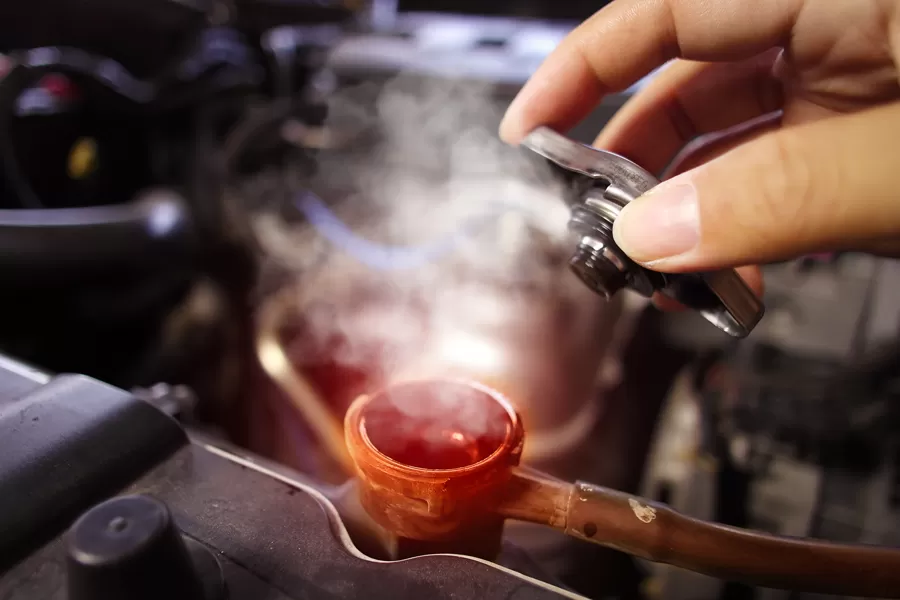Trust the Leader: Why We Make the Best Blown Head Gasket Repair Sealants
Trust the Leader: Why We Make the Best Blown Head Gasket Repair Sealants
How 500+ hours of research and development led to the best head gasket sealer lineup anywhere
A blown gasket is one of the worst things you hear about your car. For most people, a leak in your car’s head gasket means a $1,500+ repair bill, and several days (if not longer) of your car being on the sideline due to a leaking head gasket.
Nobody has time for that, and obviously nobody wants to spend money on an expensive repair when a powerful family of chemical-based, proven, head gasket sealers is available – for all types of head gasket problems.
Bar’s Leaks is the national leader in fixing leaking head gaskets. We know what we’re talking about. We’ve helped hundreds of thousands of customers repair their blown head gaskets without having to stare at an expensive repair bill or lose their car for a couple weeks. Heck, we invented the chemical head gasket sealer category.
So, we can help you too. But first, do you actually know that your head gasket has failed?

How your head gasket can fail
Head gaskets are among the most overworked gaskets in an engine, because they have to be able to seal many things simultaneously. They seal coolant, oil, and engine combustion compression away from each other and the external world. When head gaskets do blow, they can fail in a number of different ways (this is why they are not always easy to diagnose).
When a head gasket begins to leak, the problem can present in different ways. Here are some of the most common symptoms of a blown head gasket:
-
Oil to outside leak
One of the most obvious symptoms. If the head gasket fails between the engine’s internal oil system and the external world (i.e. outside of the engine), you will notice oil leaking in the engine bay and sometimes even on your driveway or parking lot.
While this type of head gasket leak is not as immediately dangerous as some of the other types of head gasket failure, it still needs attention and, in our experience, will eventually get worse over time and with miles driven. Often, this sort of leak may result in less oil pressure. Be sure to watch the engine oil level if you notice this, and don’t let engine oil levels get low. Top off if you have to.
-
Coolant to outside leak
We hear this a lot from our customers. It’s not as easy to identify as an oil-to-outside leak, but it is common.
What makes this trickier to notice is that leaking coolant drips to the ground while driving, or evaporates. This means you have little visual ID of where the head gasket leak is coming from. If a head gasket fails between an engine water channel and the outside of the engine, then you have a coolant leak that can be slow, moderate, or pretty aggressive.
Over time, your coolant levels will run low and you will find yourself needing to top off frequently. If your coolant system gets too low, overheating becomes a risk.
-
Coolant to oil leak
If your head gasket fails somewhere between an oil channel and a coolant channel it very quickly leads to engine oil and coolant mixing. This will result in contaminated oil, aka oil looking like a blended “milkshake” instead of clean oil. When you hear that blown head gaskets create a white, creamy sludge of your oil, this is what is happening. It’s the coolant contaminating your oil, and this is the visual result of this contamination.
But wait – it is also common for it to go the other way: oil to coolant. This is because the oil passage pressure is much higher than the coolant pressure. In this situation, the coolant will turn milky and you will notice an oil film inside the cooling system.
-
Compression to outside leak
We don’t hear about this type as often as some of the head gasket symptoms above, but compression-to-outside leaks do happen in some cases, especially if the engine design is known for this type of problem. A compression-to-outside leak means that some of your engine’s compression is bleeding out of the engine, which causes a sharp “ticking” noise when your car is idling (when you drive regularly the tick often goes silent). This type of head gasket failure often leads to rough idle, jerky acceleration, and a loss of power.
-
Compression leak to coolant
This is another one that we hear about, but not as often as some of the symptoms mentioned above. If your head gasket fails between a cylinder and a water channel, the resulting crack/fissure will allow exhaust gases to bleed into the cooling system, resulting a pressurized cooling system (due to exhaust gas buildup) and eventually overheating. This increased pressure in the cooling system can cause hoses to blow off their fittings, which results in an immediate major problem.
Like what? Well, this can result in a damaged radiator, hoses, and other cooling system components. This type leak also results in a massive drop in coolant level, causing overheating very quickly.
This type of compression leak also permits coolant to bleed into the cylinder itself, where it combusts as steam. This gives the telltale blown head gasket “white smoke” coming out of the exhaust pipe, as well as a noticeably sweet smell in the cockpit (sometimes) and from outside the vehicle (all the time). Another downside is that as this coolant is burned off in the cylinders, it has to travel through your exhaust and emissions systems, which can lead to damage to both.
-
Compression leak between cylinders
If your head gasket fails between cylinder walls, it allows your engine’s compression to leak from one cylinder to another. This is another way your car can lose compression due to a blown head gasket. This sort of head gasket leak usually presents itself as misfires, rough idle and acceleration, and power loss (most noticeable during acceleration).
-
Compression leak into oil channels
If the head gasket fails between the cylinder and an oil channel, compression will bleed into the oil system. This means your oil system will become pressurized, which isn’t a good thing. Hot compression gasses will damage the lubrication of vital bearings, such as the crankshaft main bearing (something we’ve seen hundreds of times).
This symptom also leads to the piston to drawing oil into the cylinder, where it will be burned off as part of the regular combustion process. As you might imagine, this will eventually cause a drop in oil levels, and will also mean you see the dreaded “blue smoke” from the exhaust, which of course is from your engine burning oil.
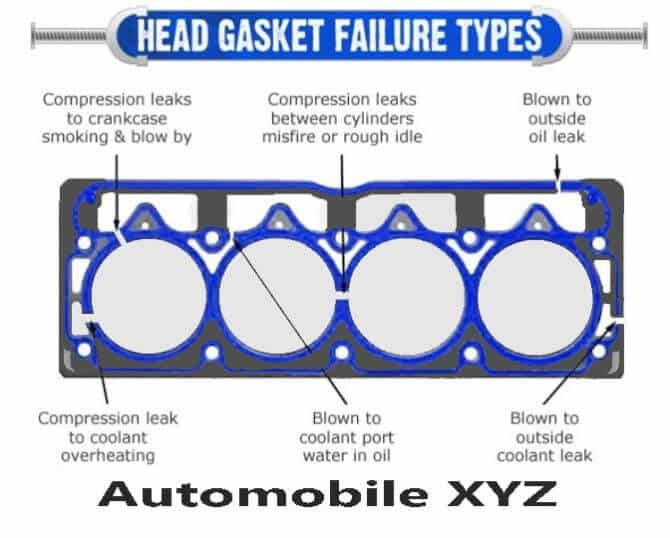
These are the five main symptoms we talk to customers about all of the time. Depending on how bad your blown head gasket leak is, you may notice one or more of these symptoms.
I’ve heard that chemical head gasket sealers can’t seal leaks. What’s the truth?
Let’s start with the most obvious rule here: if your head gasket has a mild or moderate leak, a quality head gasket fix product will definitely seal leaks. But if your head gasket is badly damaged – with major leaks, rapid overheating, or multiple symptoms – it might be too far gone for any chemical head gasket repair to work. It’s just physics.
There are head gasket leak situations that simply aren’t possible to fix with a chemical head gasket sealer. For example, there is no chemical technology available to make a product that will safely seal an oil to combustion, or oil to external head gasket leak.
So the trick is to catch your head gasket leak as early as possible. If you can catch the damaged head gasket leak early enough, you stand a very good chance of repair using a blown head gasket repair sealer.
So chemical head gasket sealers will certainly increase your vehicle’s life, if you catch the leak early enough. They will also save you major money, as most head gasket leaks cost $1,500-$3,000 for a full physical repair.
After using a head gasket sealer, keep checking the car for leaks and other symptoms for about a day. It is easy to see if the sealants work, because you will notice immediately that overheating is no longer a problem.
The general rule we usually recommend to customers is this: if your car can run for 15 to 20 minutes without overheating, your leaking head gasket issue is likely fixable by a quality chemical repair solution. If your car overheats quicker, the cracked head gasket issue might be too severe. In that unfortunate case, a full physical head gasket replacement is probably necessary.
Everyone recommends Bar’s Leaks for blown head gaskets. Why?
How can you know what brands of head gasket sealer work? Well, we might know a thing or two.
For starters, Bar’s Leaks was the first to pioneer the entire category of head gasket sealers. We had a team of chemists working on this problem before anyone else in the industry. We have a family of head gasket repair sealer products that not only are a permanent solution, but also the result of 500+ hours of research and formulation testing. We discarded dozens of formulas until we found the ones that actually worked – in our lab machinery, as well as in the real world on test cars with leaking head gaskets. We did not simply rush products into the market that have no test data behind them.
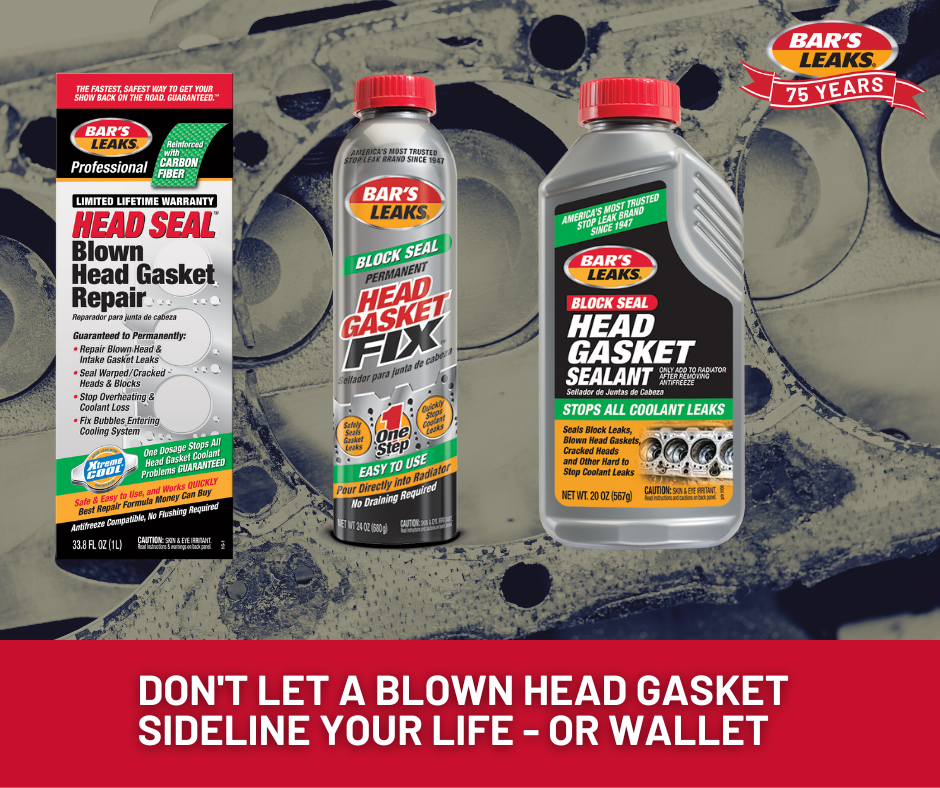
Secondly, Bar’s Leaks is known as the worldwide leader in chemical repair solutions for all types of leaks. Head gaskets, engine oil, cooling systems, radiator leaks, transmissions, power steering, hydraulics – you name it. If you have a leak coming from just about anywhere in your car, we can help.
We always say that nobody is happy buying a Bar’s Leaks repair product, but they’re glad they did. Not happy because it means their car has a leaking problem (which is never a good thing), but glad because they discover Bar’s Leaks can fix their problem without having to deal with a hard (physical) repair or dealership. In the end, this means that using the best head gasket sealer product not only saves you considerable money, but also prevents your car from being in the shop for several days or weeks.
OK, fine. What is the best head gasket repair product for my situation?
Bar’s Leaks offers the best head gasket sealers to suit every budget and installation ability. Let’s cover those now.
Bar’s Leaks Head Seal Blown Head Gasket Repair (part HG-1)
This is our best, most professional-grade formula. Bar’s Leaks Professional Head Seal Carbon Fiber Blown Head Gasket Repair is the strongest antifreeze-compatible solution on the market, period. It penetrates a leaking, damaged or blown head gasket, drying to form a seal that’s actually stronger than the original head gasket itself. This gives a permanent fix.
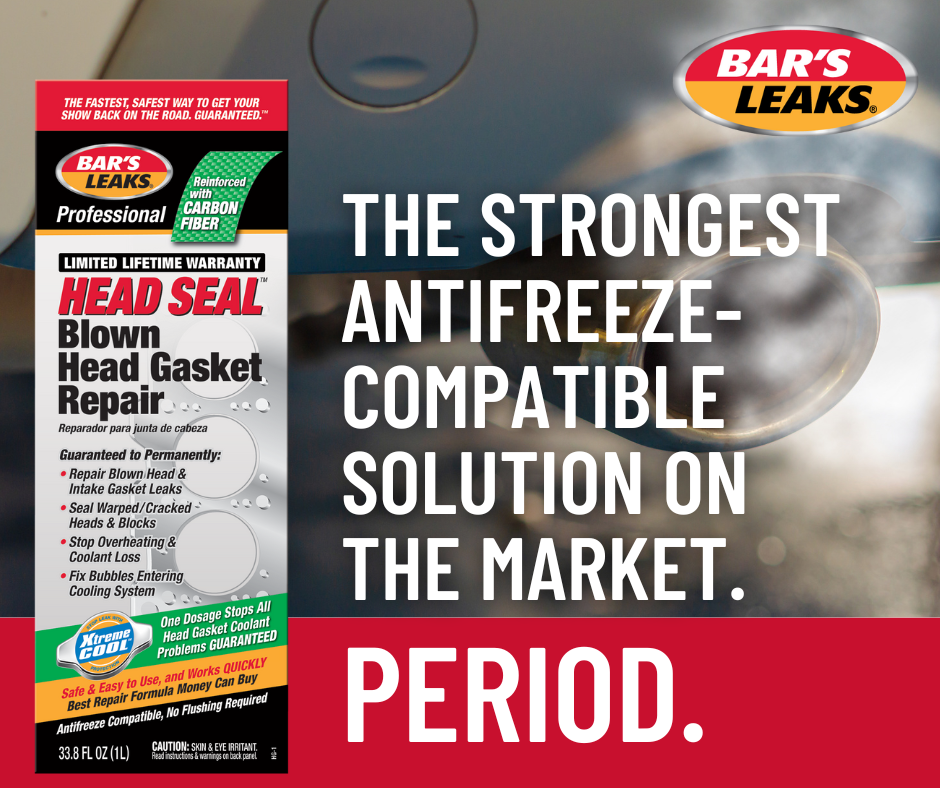
Product highlights:
- Repairs blown head gasket and intake gasket leaks.
- Seals warped heads and blocks.
- Stops engine overheating and coolant loss.
- Fixes bubbles entering the cooling system.
- Over 2.5 million bottles sold.
- Good for four, six or eight cylinder engines.
Product performance:
- Sealing power: ⭐⭐⭐⭐⭐
- Ease of installation: ⭐⭐⭐⭐⭐
- Price: (around $49, depending when where you buy it and if promotions are offered)
This is the gold standard of the industry, the best head gasket sealer we’ve ever developed.
How much time and inconvenience is involved in taking your car to a mechanic for blown head gasket repair? The lost time is a frustration, and the money it takes to alleviate a head gasket leak is overwhelming. That’s because fixing a head gasket can cost you quite a bit (typically $1,500-$3,000). We know you would rather spend that money on the things that matter most. That’s why we created this professional-grade, easy-to-use head gasket solution. It’ll repair your leaking head gasket and save you money.
Bar’s Leaks Professional Carbon Fiber Blown Head Gasket Repair is the strongest antifreeze-compatible solution on the market, period. It penetrates a leaking, damaged or blown head gasket, drying to form a seal that’s actually stronger than the original head gasket itself. It’s the best formula to stop all other coolant leaks in plastic, cast iron, copper and aluminum radiators, heater cores, freeze plugs, gaskets, intake manifolds, cylinder heads and engine blocks. The special formulation also contains Xtreme Cool™, which stops overheating and reduces water temperature. Our fast, effective head gasket sealer is the result of decades of research and testing by top-flight chemical engineers. When you choose Bar’s Leaks for blown head gasket repair, you’ve got a product that’s designed to fit perfectly into the lifestyle and budget of everyday drivers.
A physical blown head gasket repair can be expensive, which is why Bar’s Leaks is proud to offer an affordable solution for your head gasket leak. And best of all, you don’t need any automotive expertise to install our head gasket sealer. If you know how to open the hood of your car, you can use this blown head gasket repair product.
INSTALLATION DIRECTIONS:
Protect from freezing.
- Install only in a cold engine. Shake bottle well. Remove radiator cap and pour the correct amount of product in per the dosage chart. Fill radiator and reservoir/overflow tank to proper level and reinstall radiator cap. TIP: Radiator cap may be on top of radiator, on engine, mounted on a hose, or a screw cap on the pressurized reservoir overflow tank.
- Turn heater on hot and fan on high. Run engine until thermostat opens or normal operating temperature is reached. Turn vehicle off and allow engine to cool. This may take up to 30 minutes or longer.
- Top off radiator (add coolant as needed) and either run engine at high idle (approximately 1200 RPM’s for vehicles with a tachometer) or gently drive for 15 minutes. Turn vehicle off and allow engine to cool.
- Top off radiator and leave Bar’s Leaks Head Seal Blown Head Gasket Repair in system for continued protection. Drive vehicle as normal. Most leaking gaskets seal instantly, but some can take additional thermocycles, which happen over a few days of usage.
Bar’s Leaks Block Seal Permanent Head Gasket Fix (part 1111)
This easy-to-use formula contains a combination of antifreeze-compatible sodium silicate sealing liquid and various gasket-sealing particles that penetrate gaps and cracks and harden to permanently stop internal and external leaks. It’s liquid permanent repair technology for damaged, leaking or blown head gaskets, and with over two million bottles sold, you can count on it to perform. We have a team of top-flight chemical engineers who are always innovating and pursuing ways to improve our existing products. As auto manufacturers introduce new technologies, we offer new products that will help everyday drivers save time and money through fast and effective solutions.
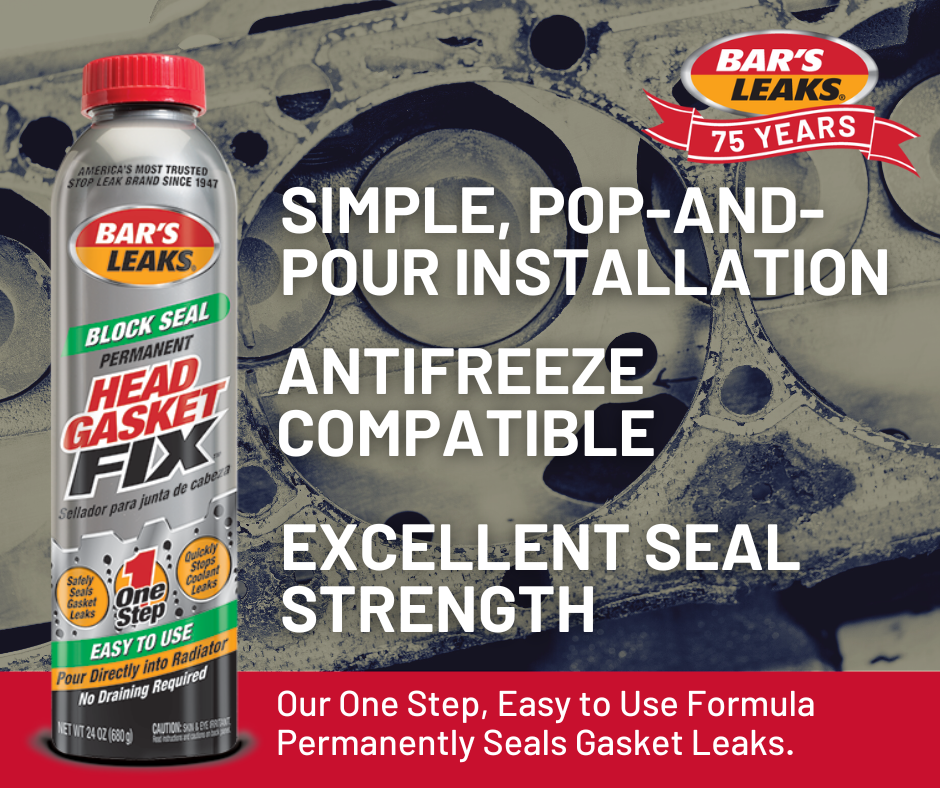
Product highlights:
- One step, easy-to-use.
- Safely seals gasket leaks.
- Antifreeze-compatible sodium silicate formula.
- No draining required.
- Over two million bottles sold.
- Good for four, six or eight cylinder engines.
Product performance (out of five):
- Sealing power: ⭐⭐⭐⭐
- Ease of installation: ⭐⭐⭐⭐⭐
- Price: (around $30, depending when where you buy it and if promotions are offered)
INSTALLATION DIRECTIONS:
Protect from freezing.
- Allow engine to cool. Make sure engine is cool enough so radiator cap can be safely removed.
- Shake well. Pour Head Gasket Fix directly into radiator. If using in a small cooling system including all 3 and 4 cylinder engines, use half bottle. TIP: If direct access to radiator is not available and if overflow tank is pressurized, you can install in tank.
- Fill radiator and overflow tank to proper level and reinstall radiator cap. Start engine.
- Turn heater on hot and fan on high.
- Idle engine for 15 minutes.
- Turn off and allow engine to cool.
- Top off (fill up) radiator and leave Bar’s Leaks Head Gasket Fix in cooling system for continued protection. Drive vehicle as normal. Many leaks seal instantly, but some can take a few additional days of usage.
Bar’s Leaks Block Seal Head Gasket Sealant (part 1100)
This product is more involved with the installation process, but mainly just more time consuming. Just a little more automotive expertise is needed. The upside? The seal strength is equivalent to that of our bestselling product (Head Seal Blown Head Gasket Repair HG-1), and the price is considerably cheaper.
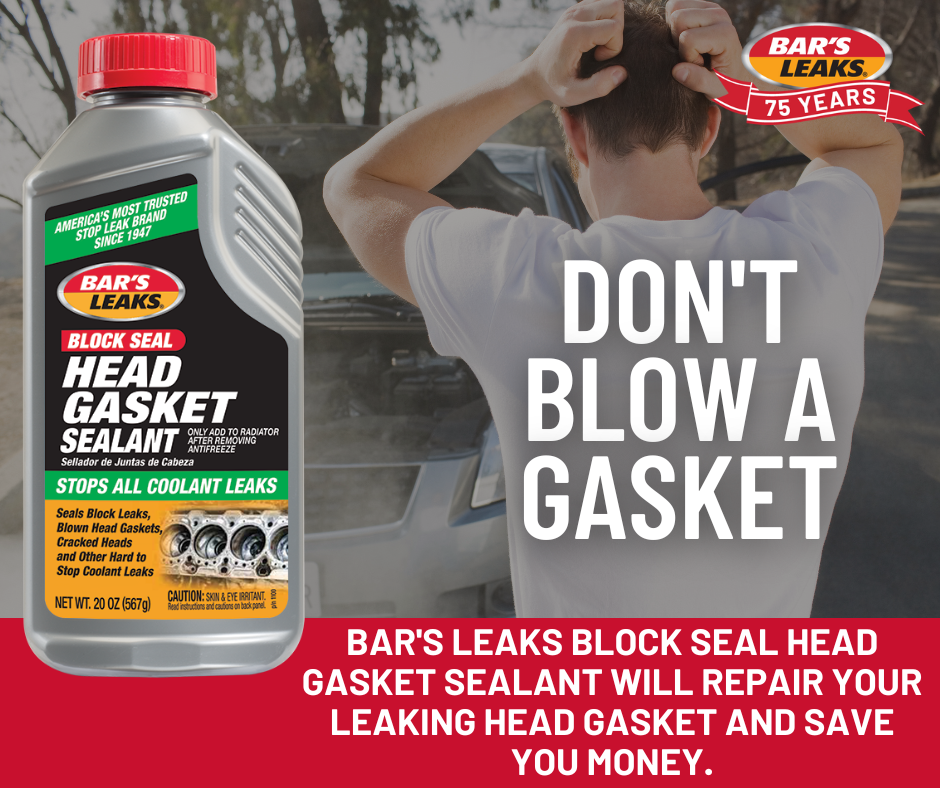
One thing to note is that this formula is not antifreeze compatible, which means this product must be added only after all antifreeze is flushed and removed (via simple radiator flush procedure). This isn’t a big deal; it just means you need to do a radiator flush before installation. The good news here is that you know the product will be installed into a clean, fresh cooling system, and the seal strength is excellent.
It’s just a matter if you have the time/patience/ability to perform the flush before installation.
Product highlights:
- Seals cracked heads.
- Repairs blown and leaking head gaskets.
- Stops block leaks.
- Good for four, six or eight cylinder engines.
Product performance (out of five):
- Sealing power: ⭐⭐⭐⭐⭐
- Ease of installation: ⭐⭐⭐
- Price: (around $15, depending when where you buy it and if promotions are offered)
INSTALLATION DIRECTIONS:
WARNING: Head Gasket Sealant is NOT COMPATIBLE with antifreeze and must only be added to the cooling system after ALL ANTIFREEZE has been flushed and removed.
DANGER: Opening the cooling system while engine is hot or running may cause severe burns.
DISPOSAL: Observe local laws & regulations. Where permitted, dispose of in sanitary sewer system. Never pour on the ground or in a storm sewer system.
Protect from freezing.
- Engine must be cool enough to safely open the radiator cap. (This could take 30 minutes or longer). Drain and completely flush antifreeze from cooling system and overflow tank. Using a flush “T” with garden hose works best. If cooling system is dirty, use a good quality flush following manufacturer’s instructions. ALL antifreeze must be removed or clogging may occur.
- Shake well. Mix Head Gasket Sealant in a bucket or container with approximately 3 quarts of warm water. Pour this mixture directly into the radiator. If using in a small cooling system, including all 4 cylinder engines, mix ½ bottle of the Head Gasket Sealant with the warm water. TIP: If you do not have access to your radiator and vehicle has a pressurized reservoir, then product can be added to reservoir. If not then remove top hose where it connects to the top of radiator and install product in hose. Reattach and tighten clamp.
- Fill cooling system with water and reinstall radiator cap.
- Start engine, turn heater on hot and fan on high.
- Run engine for 10 minutes or until thermostat opens.
- Turn vehicle off and allow engine to cool. Allow enough time so it is safe to open cap.
- Top off (fill up) cooling system with water and reinstall radiator cap.
- Run engine at idle until normal operating temperature is reached. Continue running engine at idle for 15 minutes.
- Turn vehicle off and allow 45 minutes to cool.
- Top off cooling system with water as needed and reinstall radiator cap.
- Run engine at idle until normal operating temperature is reached. Continue running engine, but at high idle (approximately 1200 RPM’s for vehicles with a tachometer) for 20 minutes.
- Turn vehicle off and allow engine to cool for 1 hour. TIP: For vehicles with intermittent or very minor leaks, it is recommended to follow step 12 by idling vehicle for one hour.
- Remove radiator cap and drain system.
- Leave drain open and radiator cap off for 12 to 24 hours. If temperature is below freezing, vehicle must either be kept heated or immediately go to step 15.
- Flush entire cooling system and refill with fresh coolant per the manufacturer’s recommendations.
I still have questions about my car’s leaking head gasket problem. Can you help point me in the direction of the right head gasket sealer?

We sure can.
We have a US-based Customer Support team available Monday-Friday, 9 am – 5 pm. They can be reached at 800-345-6572. All of our Customer Support members are actual humans based here in Michigan. There are no annoying phone menu mazes to deal with, and the team has fielded thousands of calls from customers just like yourself.
If you’d rather reach out online, you can simply contact us via the web and a Customer Support rep will get in touch with you right away.
Alternatively, you can reach out to us on Facebook if that’s more your thing, and we’ll be sure to hook you up with the proper Customer Support rep who will be able to discuss which gasket fix repair sealer will work best for you.
Finally, if you want to find a retailer near you that carries any of our products that help you do your own head gasket fix, use our Store Locator for some quick directions.



